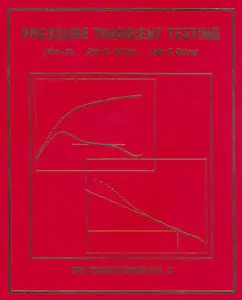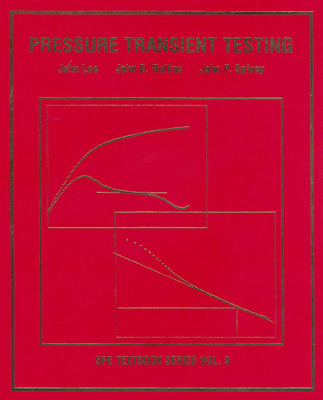"Pressure Transient Testing" by John Lee, John B. Rollins & John P. Spivey
Henry L. Doherty Memorial Fund of AIME-SPE. Society of Petroleum Engineers. SPE textbook series, vol.9
SРЕ | 2003 | ISBN: 1555630995 9781555630997 | 372 pages | PDF | 26 MB
Henry L. Doherty Memorial Fund of AIME-SPE. Society of Petroleum Engineers. SPE textbook series, vol.9
SРЕ | 2003 | ISBN: 1555630995 9781555630997 | 372 pages | PDF | 26 MB
This textbook presents the fundamentals of pressure-transient test analysis and design in clear, simple language and explains the theoretical bases of commercial well-test-analysis software. Test-analysis techniques are illustrated with complete and clearly written examples. Additional exercises for classroom or individual practice are provided.
With its focus on physical processes and mathematical interpretation, this book appeals to all levels of engineers who want to understand how modern approaches work.
Contents
Chapter 1. Fundamentals of Fluid Flow in Porous Media
1.1 Overview
1.2 Derivation of the Diffusivity Equation
1.3 Initial and Boundarcy Conditions
1.4 Dimensionless Groups
1.5 Solutions to the Diffusivity Equation
1.6 Superposition in Space
1.7 Superposition in Time
1.8 Deconvolution
1.9 Chapter Summary
1.10 Discussion Questions
Chapter 2. Introduction to Flow and Buildup-Test Analysis: Slightly Compressible Fluids
2.1 Overview
2.2 Analysis of Flow Tests
2.3 Analysis of Pressure-Buildup Tests
2.4 Complications in Actual Tests
2.5 Analysis of Late-Time Data in Flow and Buildup Tests
2.6 Analyzing Well Tests With Multiphase Flow
2.7 Chapter Summary
Chapter 3. Introduction to Flow and Buildup-Test Analysis: Slightly Compressible Fluids
3.1 Overview
3.2 Pseudopressure and Pseudotime Analysis
3.3 Pressure and Pressure-Squared Analysis
3.4 Non-Darcy Flow
3.5 Analysis of Gas-Well Flow Tests
3.6 Analysis of Gas-Well Buildup Tests
3.7 Chapter Summary
Chapter 4. Well-Test Analysis by Use of Type Curves
4.1 Overview
4.2 Development of Type Curves
4.3 Application of Type Curves-Homogeneous Reservoir Model, Slightly Compressible Liquid Soli
4.4 Application of Type Curves-Homogeneous Reservoir Model, Compressible Fluids
4.5 Correcting Initial Pressure in a Well Test
4.6 Reservoir Identification With Type Curves
4.7 Systematic Analysis Procedures for Flow and Buildup Tests
4.8 Well-Test-Analysis Worksheets
4.9 Chapter Summary
Chapter 5. Analysis of Pressure-Buildup Tests Distorted by Phase Redistribution
5.1 Overview
5.2 Description of Phase Redistribution
5.3 Phase-Redistribution Model
5.4 Analysis Procedure
5.5 Chapter Summary
Chapter 6. Well-Test Interpretation in Hydraulically Fractured Wells
6.1 Overview
6.2 Flow Patterns in Hydraulically Fractured Wells
6.3 Flow Geometry and Depth of Investigation of a Verticaly Fractured Well
6.4 Specialized Methods for Post-Fracture Well-Test Analysis
6.5 Post-Fracture Well-Test Analysis With Type Curves
6.6 Effects of Fracture and Formation Damage
6.7 Chapter Summary
Chapter 7. Interpretation of Well-Test Data in Naturally Fractured Reservoirs
7.1 Overview
7.2 Naturally Fractured Reservoir Models
7.3 Pseudosteady-State Matrix Flow Model
7.4 Transient Matrix Flow Model
7.5 Chapter Summary
Chapter 8. Drilltem Testing and Analysis
8.1 Overview
8.2 Conventional DST
8.3 Conventional DST Desing
8.4 DST-Monitoring Procedures
8.5 DST Analysis Techniques
8.6 Closed-Chamber DST
8.7 Impulse Testing
8.8 Chapter Summary
Chapter 9. Injection-Well Testing
9.1 Overview
9.2 Injectivity Testing in a Liquid-Filled Reservoir: Unit-Mobility-Ratio Reservoir Conditions
9.3 Falloff Testing in a Liquid-Filled Reservoir: Unit-Mobility-Ratio Reservoir Conditions
9.4 Estimating Average Drainage-Area Pressure
9.5 Composite-System-Test Analysis for Nonunit-Mobility-Ratio Reservoir Conditions
9.6 Step-Rate Testing
9.7 Chapter Summary
Chapter 10. Interference and Pulse Testing
10.1 Overview
10.2 Interference Tests
10.3 Pulse Tests
10.4 Recommendations for Multiple-Well Testing
10.5 Chapter Summary
Chapter 11. Desing and Implementation of Well Tests
11.1 Overview
11.2 Types and Purposes of Well Tests
11.3 General Test-Desing Considerations
11.4 Pressure Transient Test Design
11.5 Deliverability-Test Design
11.6 Chapter Summary
Chapter 12. Horizontal Well Analysis
12.1 Overview
12.2 Steps in Evaluating Horizontal Well-Test Data
12.3 Horizontal Well Flow Regimes
12.4 Identifiying Flow Requirements in Horizontal Wells
12.5 Summary of Analysis Procedures
12.6 Field Examples
12.7 Running Horizontal Well Tests
12.8 Estimating Horizontal Well Productivity
12.9 Comparison of Recent and Older Horizontal Well Models
12.10 Chapter Summary
Appendix A. Dimensionless Groups
Appendix B. Solutions to the Radial-Flow Diffusivity Equation
Appendix C. Derivations of the Diffusivity Equation Multiphase Flow (Perrine and Martin) Linear Flow of Gas
Appendix D. Shape Factors for Various Single-Well Drainage Areas
Appendix E. Validation of Method of Images
Appendix F. Determining Pressure-Data Derivates
Appendix G. Reservoir-ldentification Worksheets
Appendix H. Well-Test Analysis Worksheets
Appendix I. Example Well-Test Analysis Using Worksheets, Example 4.5
Appendix J. Worksheets for Post.Fracture Well-Test Analysis
Appendix K. Worksheets for Well-Test Desing
Appendix L. Reservoir-Fluid Properties
Nomenclature
Author Index
Subject Index
with TOC BookMarkLinks



